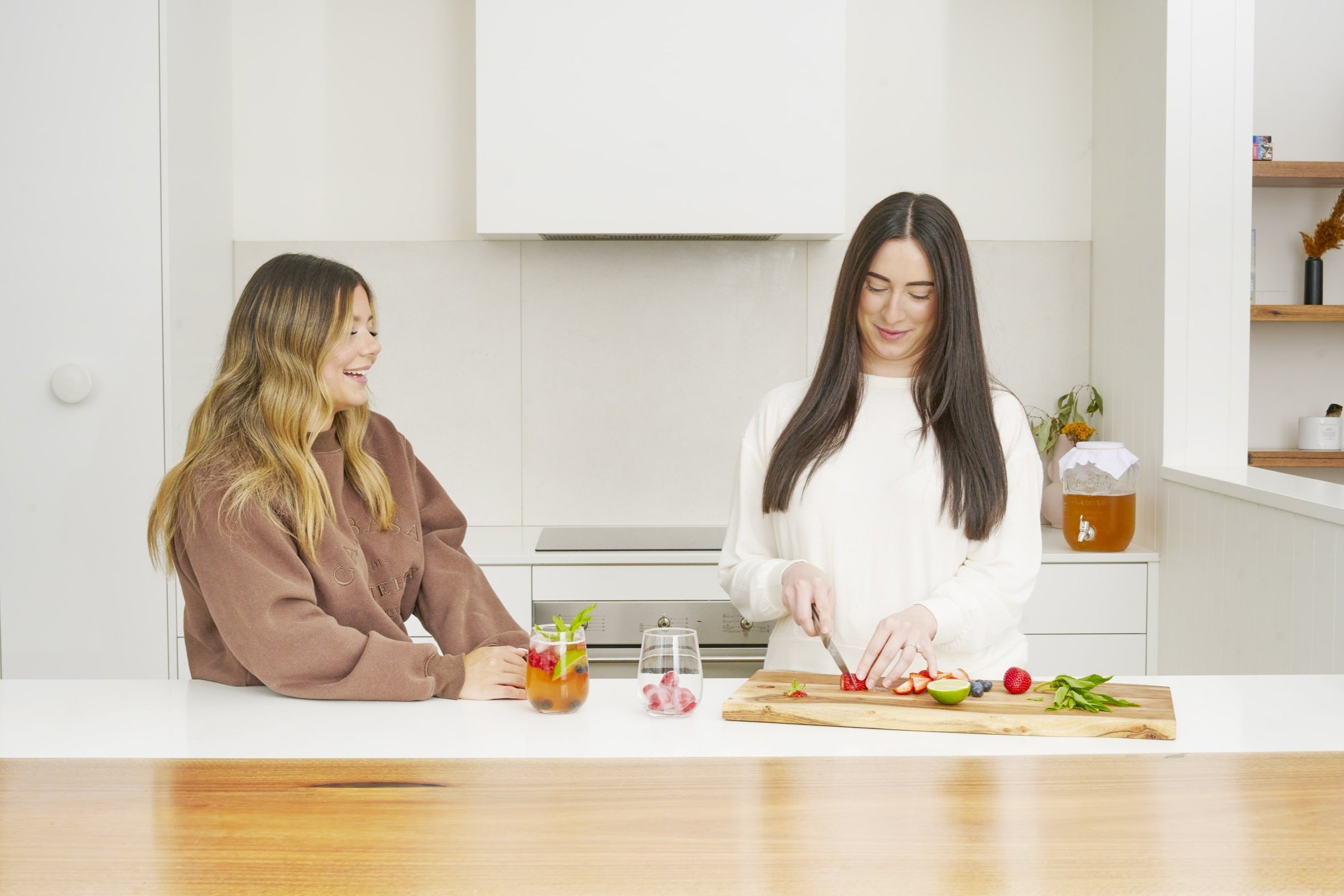
Frequently
ASKED QUESTIONS

-
That’s absolutely normal. The SCOBY can float on top or bottom of the brewing jar, that’s all fine. After few days you should have a thin film on top of your brew, this is the new baby SCOBY.
-
The scoby lasts easily for 3 months. They are very robust for a short period of time and can easily withstand transport.
-
It can help you track the progress of your Kombucha brew. It is optional, but it can help you to distinguish when your own Kombucha starter is acidic enough (2.5-3ph is good) to start the next batch. If your starter/Kombucha is higher than 3ph use more of it then the recommended 10% of your total brew. Do not dip the strips into Kombucha that you intend to drink, few drops on the strip are enough.
-
All the scobys are freshly packed and send out twice a week. The standard free shipping takes usually 5-10 business days depending on where you live. Express usually takes about 2-5 business days.
-
-
Going away for less than two weeks – just leaf your kombucha jar with about 15% full and make a new brew on return and be ready to bottle in a few days.
Going away for four to 6 weeks – do the above or place your scoby in a scoby hotel. A scoby hotel is an extra jar that you keep full with scoby/s and kombucha. Leave your scoby hotel in a dark, cool place. You can leave your scoby hotel for 6 weeks.
-
In a few simple words, home brewed kombucha just tastes much better than store-bought kombucha.
Why is that and how? First of all, every one of us has a different taste and the kombucha producers especially the larger ones try to cater to the majority of people which makes it taste more like a fizzy drink rather than real kombucha. Plus, they also have to care about cost of production, shelf life and the already naturally low level of alcohol in Kombucha. That’s why many producers deviate from the original formulas and often use cheap ingredients. This is also one of the main reasons it is not ideal to grow a SCOBY from store-bought kombucha.
Secondly, if you brew kombucha yourself, you have control over the ingredients you use and the fermentation time of your brew which results in the taste being more to your liking! Maybe you like it slightly sourer or sweeter this is something you have control over. Plus you can flavour your kombucha the way you like it. Which is a fun process to do and experiment with 😊
Thirdly, you just care more about the brew then an employee that gets payed to brew kombucha and you put more love into the process. Its like with many things, if you do it yourself it just taste better. I guess it’s the kombucha homebrew factor.
-
A Kombucha Jar Is Your Scoby's Home. In order to have the best possible brew, it is important to leave the SCOBY undisturbed.
Why you probably ask?
Let me answer this question for you. Your delicious kombucha goes through two cycles of fermentation an aerobic and an anaerobic phase. The aerobic phase occurs at the beginning of the fermentation process while the anaerobic phase occurs to the end of the process. That happens when your brew is covered with a new baby SCOBY, through which less oxygen goes into the brew. Both cycles are very important!
Every time the liquid is disturbed through testing and taking liquid from the top, the mushroom (SCOBY) will most likely sink and a new SCOBY will begin forming over again. The gluconic acid will suffer as the gluconobacter spends energy rebuilding the SCOBY. The gluconobacter sees their mushroom as controlling the yeasts. Depriving the yeast of oxygen, the yeasts produce greater amounts of alcohol. The gluconobacter prefer alcohol to sugar.
By using a kombucha jar with a tap, you are able to test your kombucha without disturbing your newly made SCOBY on top of your kombucha tea.
If you are looking to purchase a jar with a tap, please check out the link below for our 4 Litre and 8 Litre kombucha Jars.
-
Ensure that your brewing vessel is properly covered with a breathable cloth, which allows airflow while keeping out unwanted contaminants. Maintain the correct temperature and pH levels for fermentation. Additionally, regular monitoring and visual inspections can help detect any potential issues early on.
Remember, while mould can be a concern in Kombucha brewing, it is relatively rare when proper brewing practices are followed. By maintaining cleanliness, using quality ingredients, and being attentive during the fermentation process, you can enjoy the benefits of delicious and safe homemade Kombucha.
-
We are using two different shipping services, Australian Post and FastWay. If your parcel went with FastWay couriers then you should have received a confirmation email with a tracking number from their system, you may have to check your spam folder for it. If your parcel went with Australian Post, then you should have received a confirmation email directly from Karl Kombucha with your tracking details.
-
You know its ready when its to your liking. I usually start testing my Kombucha after 4-5 days.
-
The Jar spigot is made of food grade plastic (ABS) and the seal is made from food grade silicon. So nothing to worry about.
-
Especially at the beginning of your brewing career, it seems hard to generate some fizz. This comes down to many factors like yeast balance, brewing temperature, sugar amount and so on. If you like to find out more about tricks on how to make your boch fizzier then just click on this link.
-
Typically, this accrues through rapid yeast production in your Kombucha brew. The yeast is active and not big enough to sink to the ground and that makes the brew appear cloudy. Its nothing to worry about and often goes away especially during second fermentation in the bottle.
-
The tea must come from the Camellia sinensis plant and be preferably free of any extra flavour. What does that mean? The four main types of tea from the plant Camellia sinensis are Green tea, Black tea, White tea and Oolong tea. Try to use organic tea as it is free of pesticide residue which otherwise could interfere with your SCOBY.
-
Most likely this widely held belief that it is a Mushroom, arises from the obvious resemblance of the Scoby to a large mushroom cap. The kombucha culture is, in fact, a Symbiotic Culture of Bacteria and Yeast. Or in short SCOBY
Mushrooms are fungi and so are yeast, so in that regard kombucha cultures and mushrooms are in the same family. But they are distant cousins, not siblings.
The Kombucha culture – which is the living material that drives the fermentation – is called a SCOBY (symbiotic culture of bacteria and yeast).
WHAT EXACTLY IS A SCOBY?
The Scoby is a cellulose mat that houses a mass of bacteria and yeast. The primary bacteria in a scoby is Acetobacter xylinum, which produces copious amounts of cellulose, although there could also be any of several other strains. The bacteria and yeast in a scoby depend on each other in that the by-product of the yeast fermentation feeds the bacteria and the by-product of the bacteria fermentation feeds the yeast. The matlike cellulose structure protects the ferment against infiltration by wild bacteria and yeast and from the evaporation of the liquid while holding in more of the naturally occurring carbonation.
The symbiosis between the bacteria and yeast acts like a double karate shop to pathogenic organisms that might try to invade the brew. The low ph of the starter liquid and culture disrupts the cell membranes of unwanted bacteria, while several of the healthy organic acids that create the low ph in the first place demonstrates specific antibacterial, antiviral, and other antimicrobial properties. This dual function makes kombucha even more effective as a health tonic because it reduces the already small likelihood that the brew will develop any toxins.
I hope that this was helpful to you to understand what a Scoby is. I have sourced most of this information from “The BIG BOOK of KOMBUCHA” written by Hannah Crum & Alex LaGory. It’s a great book to read if you want to dive deep into Kombucha making.
Happy brewing,
Karl
-
Diabetes has become a serious and growing health concern and a major risk factor leading to metabolism disorders and liver-kidney dysfunctions.
Kombucha can help and is becoming an alternative natural therapeutical approach.
Initial clinical trials of the kombucha recruited participants with the disease, or those displaying pre-diabetic blood glucose levels all across the country. In an independent scientific study, researchers found:
75 per cent of participants reported improvement in their fasting blood sugar levels
1.5mmol/l fasting blood sugar levels improvement
Around one in three (31 per cent) participants reported drastic results and completely resolved their diabetes symptoms
Studies have shown that green tea in general on its own reduces blood sugar and improves insulin sensitivity [1]
According to a study with almost 300,000 participants found out that people who drink green tea had an 18 % lower risk of becoming diabetic [2]
Kombucha made from green tea is likely to be even more beneficial then just drinking green tea. Through the fermentation process kombucha enhances the benefits that green tea provides. The results of some studies proved that kombucha is a better suppressor of increased blood glucose levels and can improve insulin sensitivity. [3].
A recent study also found that kombucha could not only reduce blood sugar but it also leads to delayed absorption of ldl (low-density lipoproteins, also called the "Bad" cholesterol) and significantly raised hdl levels (high-density lipoprotein, known as “good” cholesterol). Moreover according to the same study, the kombucha seemed to protect both liver and kidney function [4].
-
A: When brewing Kombucha, mould typically appears as fuzzy patches on the surface, with colours ranging from green and blue to white and black. Anything under the surface of the new baby SCOBY on top of your batch is usually a build-up of yeast and totally normal. If unsure, please click the link below which will help you identify mould and non-mould Kombucha batches with pictures and examples.
